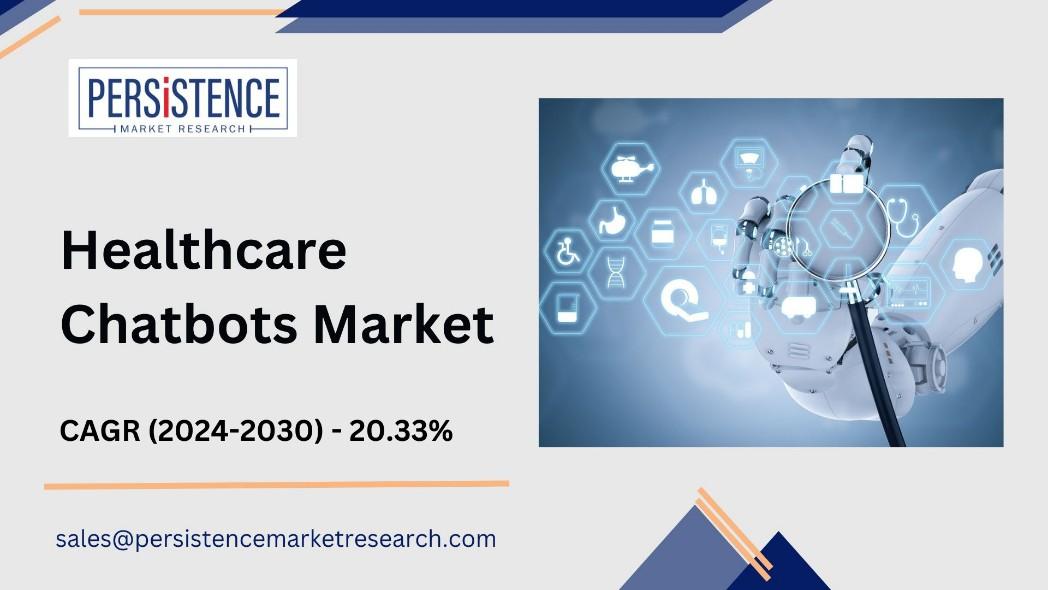Chatbots:
Applications, Market Dynamics and Growth Potential
The global healthcare chatbots market is projected to grow from US$382.1 Mn in 2024 to US$1.4 Bn by 2031, at a CAGR of 20.33%. Key drivers include the rising need for cost-effective healthcare solutions, improved patient engagement, and operational efficiencies. The software segment leads the market due to its comprehensive functionalities. North America is expected to see the highest growth rate due to increased adoption of smart devices and investments in chatbot development.
Healthcare chatbots enhance patient care by providing 24/7 availability, quick responses, and convenient access to medical information. They automate repetitive tasks, improving workflow efficiency and reducing costs. AI-powered chatbots, leveraging natural language processing (NLP) and machine learning, offer diagnostic support and personalized health advice. Advances in AI and NLP are making these chatbots increasingly reliable for patient interaction.

Exploring Diverse Applications in Modern Healthcare
The healthcare chatbots market is revolutionizing the way healthcare is delivered, providing a wide range of applications that enhance patient care, streamline operations, and improve overall healthcare experiences. Powered by artificial intelligence (AI) and natural language processing (NLP) technologies, healthcare chatbots are becoming integral components of modern healthcare systems.
Key Applications of Healthcare Chatbots:
1. Patient Engagement and Support: Healthcare chatbots play a crucial role in enhancing patient engagement by providing timely and personalized health information, answering patient queries, and offering support for chronic disease management. These chatbots ensure continuous patient interaction and foster a more proactive approach to health management.
2. Appointment Scheduling and Reminders: Chatbots streamline the appointment scheduling process by allowing patients to book, reschedule, or cancel appointments through simple conversational interfaces. They also send automated reminders to patients, reducing noshow rates and improving clinic efficiency.
3. Symptom Checking and Triage: Chatbots equipped with AI and NLP capabilities can perform preliminary symptom checking and triage. By analyzing patient-reported symptoms, these
chatbots provide possible diagnoses and suggest appropriate actions, such as visiting a healthcare provider or seeking emergency care.
4. Medication Management: Healthcare chatbots assist patients in managing their medications by providing reminders for taking medications, offering information about drug interactions, and answering questions about side effects. This application is particularly beneficial for patients with chronic conditions who require regular medication adherence.
5. Mental Health Support: Chatbots are increasingly being used to provide mental health support, offering a safe and confidential platform for individuals to discuss their mental health concerns. They provide coping strategies, stress management tips, and connect users with mental health professionals when necessary.
6. Telehealth Integration: Chatbots facilitate telehealth services by conducting initial consultations, collecting patient information, and preparing summaries for healthcare providers. They ensure a smooth transition between virtual and in-person care, enhancing the overall telehealth experience.
7. Patient Education and Awareness: Chatbots serve as valuable educational tools, providing patients with information about diseases, treatments, preventive care, and healthy lifestyle choices. They promote health literacy and empower patients to make informed healthcare decisions.
8. Billing and Insurance Inquiries: Chatbots simplify the billing process by assisting patients with billing inquiries, providing information about insurance coverage, and guiding them through the claims process. This reduces administrative burdens and enhances patient satisfaction.
9. Post-Discharge Care: After hospital discharge, chatbots support patients by providing followup care instructions, monitoring recovery progress, and answering any questions related to their treatment plan. This application helps in reducing readmission rates and ensuring better recovery outcomes.
Market Dynamics and Growth Potential:
The healthcare chatbots market is experiencing significant growth due to the increasing adoption of AI technologies, rising demand for telehealth services, and the need for efficient patient engagement solutions. As healthcare providers recognize the benefits of chatbots in improving patient care and operational efficiency, the market is poised for continued expansion.
Regional Insights:
North America: Leading the market with advanced healthcare infrastructure and early adoption of AI technologies.
Europe: Experiencing substantial growth due to government initiatives promoting digital health innovation.
Asia Pacific: Poised for the highest growth rate, driven by increasing healthcare investments and digital health initiatives.
Latin America and Middle East & Africa: Emerging markets with growing healthcare reforms and adoption of telemedicine solutions.
Conclusion:
Healthcare chatbots are transforming patient care delivery by providing a wide range of applications that enhance patient engagement, streamline operations, and improve overall healthcare experiences. As technological advancements continue and healthcare providers embrace digital transformation, the healthcare chatbots market is set for significant growth, offering innovative solutions to meet evolving healthcare needs.
